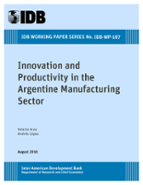Innovation and Productivity in the Argentine Manufacturing Sector
Date
Aug 2010
This paper adapts the Crepon, Duguet, and Mairesse (1998) approach to estimate the relationship between innovation and productivity and the realities of innovative activities in developing countries. Panel data for Argentina during the period 1998-2004 to estimate a structural model in which different types of firms` innovative behaviorincluding in-house activities and the incorporation of external technologiesfeeds into the probability of achieving successful results in product and process innovation, which in turn explains labor productivity. The endogeneity of this three-stage process is controlled for. The results suggest that all types of innovative activities are relevant to explain success in product and process innovation, and both are important factors to explain labor productivity. Moreover, investing systematically in R&D implies an extra payoff in labor productivity. These results suggest that investing in different types of innovative activitiesand not only in R&Dand doing in-house activities systematically contribute to firms` innovative and economic performance.



